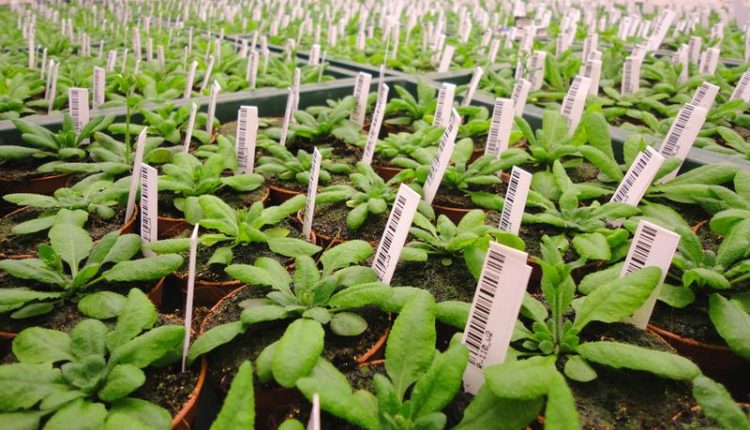Plant flowering time now predictable

The scientists discovered a molecular mechanism that causes Scottish thale cress to flower two weeks earlier than its counterparts in warmer regions. (Foto: U. Lutz/ TUM)
Plants adapt their flowering time to the temperature in their surroundings. To flower at the optimal time, they take factors like temperature, day length and temperature fluctuations into account. Although the mechanisms that cause flowering before and after winter are largely known by now, relatively little is known about how plants delay their flowering time during a cold spring.
Such processes are very important, particularly in regard of global warming with relatively small fluctuations in temperature, as the correct flowering time guarantees optimum arable yields for farmers – and also ensures that the thale cress Arabidopsis thaliana prevails in the everyday evolutionary struggle for survival.
Crucial gene for early flowerers
In the current edition of the journal PLOS Genetics, the team, headed by Professor Claus Schwechheimer from TU Munich in close cooperation with colleagues from the German Research Center for Environmental Health (Helmholtz Zentrum Neuherberg) and the Max Planck Institute in Tübingen, describe the molecular mechanism with which the thale cress Arabidopsis thaliana adapts its flowering time to the ambient temperature.
Interestingly, the first indication of the existence of this natural gene variation came from the cool latitudes of Scotland. This led the scientists to discover a molecular mechanism that causes Scottish thale cress to flower two weeks earlier than its counterparts in warmer regions. Due to the insertion of a so-called jumping gene (transposon), the formation of the crucial flowering gene was so minimal that the function of the flowering repressor no longer had any effect.
And that’s not all: Ulrich Lutz, first author of the study, was also able to show that this gene mutation has already become established in several other variants of the thale cress and controls flowering behavior in them. The researchers were even able to trace their steps here and predict the flowering behavior of the thale cress based on the presence of the jumping gene (transposon) with a high degree of accuracy. Already in the near future, it should be possible to transfer this knowledge to the flowering behavior of crop plants like rapeseed.
Research helps estimate the ecological consequences of climate change
“Our research will help to enable the estimation of the ecological consequences of climate change,” says Professor Schwechheimer. “Climate change will bring about a change in the flowering behavior of many plants. We researchers must gain a better understanding of the impacts of this temperature change on the world of plants and the organisms that depend on them.”
Plants react to the experience of a long cold winter and to extended cold periods in spring by delaying their flowering time. The molecular mechanisms with which plants perceive these cold periods differ, however. In the case of winter cereals, like winter wheat, the seed can germinate in autumn but the plant does not flower, as it needs the experience of winter to act as a wake-up call indicating that the correct time for flowering has come.
Findings can help food production
The genes that regulate this process are already known in many plants. In spring wheat, for example, they have been modified by conventional breeding that the plant flowers even if it is planted in spring. The temperatures in a cool or warm spring also affect flowering behavior; however, very little is known about this. Given that small changes of just a few degrees Celsius can have a negative impact on agricultural production, it is important to understand these processes.
The findings of the research team from the TUM Chair of Plant Systems Biology could help with the prediction and even modification of plant flowering time in the future. Such insights are also important for plant breeding to ensure that food production can be guaranteed in the long term in the context of progressive global warming.
Publication:
Ulrich Lutz, David Posé, Matthias Pfeifer, Heidrun Gundlach, Jörg Hagmann, Congmao Wang, Detlef Weigel, Klaus F. X. Mayer, Markus Schmid, Claus Schwechheimer: Modulation of Ambient Temperature-Dependent Flowering in Arabidopsis thaliana by Natural Variation of FLOWERING LOCUS M, PLOS Genetics October 22, 2015. DOI:10.1371/journal.pgen.1005588
Contact:
Prof. Dr. Claus Schwechheimer
Technical University of Munich (TUM)
Department of Plant Systems Biology
Tel: +49/(0)8161/71 2880
E-Mail: claus.schwechheimer@wzw.tum.de
http://www.sysbiol.wzw.tum.de/
Ulrich Lutz
Technical University of Munich (TUM)
Department of Plant Systems Biology
Tel: +49/(0)8161/71 2879
E-Mail: ulrich.lutz@wzw.tum.de
http://www.sysbiol.wzw.tum.de/
http://www.tum.de/en/about-tum/news/press-releases/short/article/32705/
Media Contact
All latest news from the category: Life Sciences and Chemistry
Articles and reports from the Life Sciences and chemistry area deal with applied and basic research into modern biology, chemistry and human medicine.
Valuable information can be found on a range of life sciences fields including bacteriology, biochemistry, bionics, bioinformatics, biophysics, biotechnology, genetics, geobotany, human biology, marine biology, microbiology, molecular biology, cellular biology, zoology, bioinorganic chemistry, microchemistry and environmental chemistry.
Newest articles

A universal framework for spatial biology
SpatialData is a freely accessible tool to unify and integrate data from different omics technologies accounting for spatial information, which can provide holistic insights into health and disease. Biological processes…

How complex biological processes arise
A $20 million grant from the U.S. National Science Foundation (NSF) will support the establishment and operation of the National Synthesis Center for Emergence in the Molecular and Cellular Sciences (NCEMS) at…

Airborne single-photon lidar system achieves high-resolution 3D imaging
Compact, low-power system opens doors for photon-efficient drone and satellite-based environmental monitoring and mapping. Researchers have developed a compact and lightweight single-photon airborne lidar system that can acquire high-resolution 3D…





















